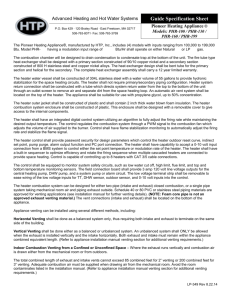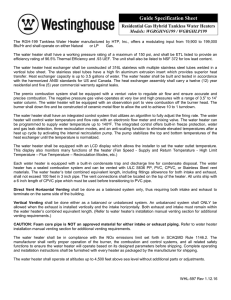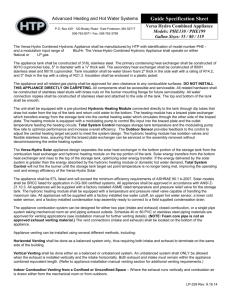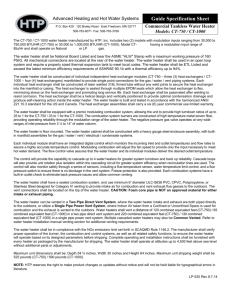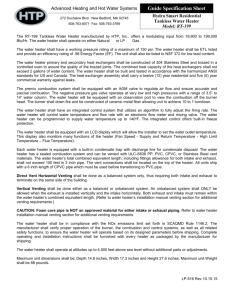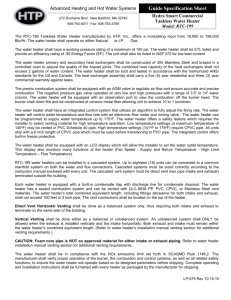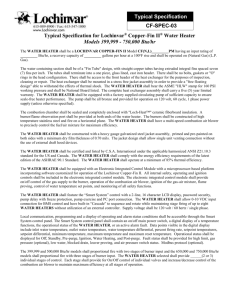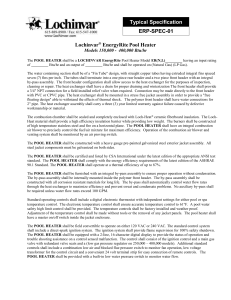Specification
advertisement
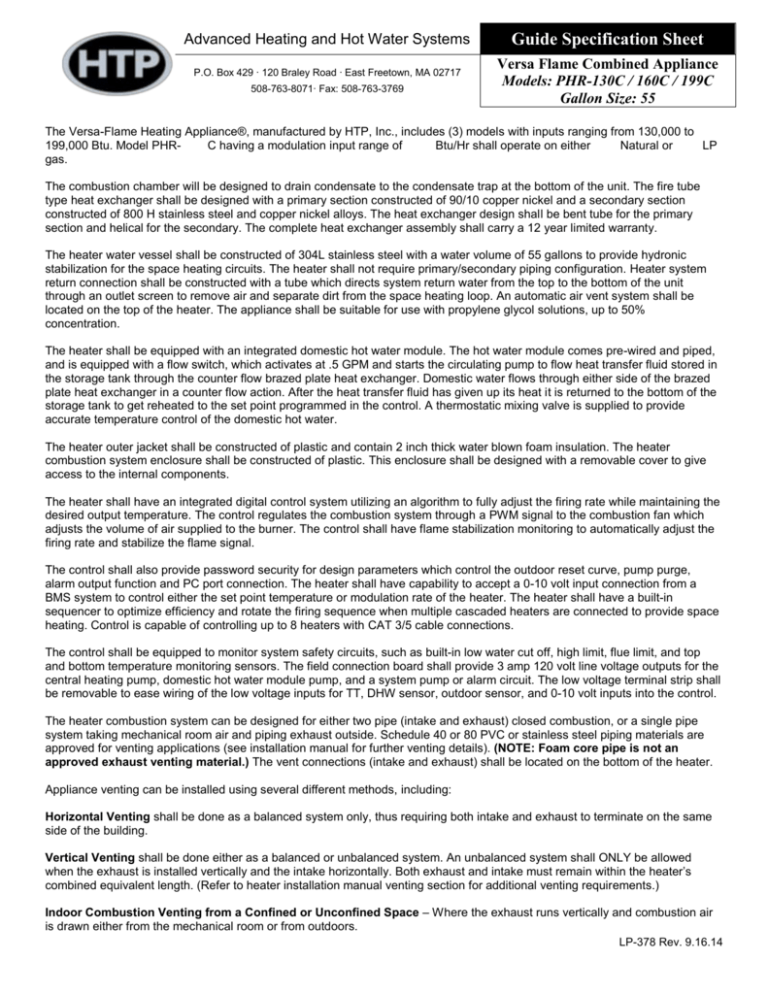
Advanced Heating and Hot Water Systems P.O. Box 429 ∙ 120 Braley Road ∙ East Freetown, MA 02717 508-763-8071∙ Fax: 508-763-3769 Guide Specification Sheet Versa Flame Combined Appliance Models: PHR-130C / 160C / 199C Gallon Size: 55 The Versa-Flame Heating Appliance®, manufactured by HTP, Inc., includes (3) models with inputs ranging from 130,000 to 199,000 Btu. Model PHRC having a modulation input range of Btu/Hr shall operate on either Natural or LP gas. The combustion chamber will be designed to drain condensate to the condensate trap at the bottom of the unit. The fire tube type heat exchanger shall be designed with a primary section constructed of 90/10 copper nickel and a secondary section constructed of 800 H stainless steel and copper nickel alloys. The heat exchanger design shall be bent tube for the primary section and helical for the secondary. The complete heat exchanger assembly shall carry a 12 year limited warranty. The heater water vessel shall be constructed of 304L stainless steel with a water volume of 55 gallons to provide hydronic stabilization for the space heating circuits. The heater shall not require primary/secondary piping configuration. Heater system return connection shall be constructed with a tube which directs system return water from the top to the bottom of the unit through an outlet screen to remove air and separate dirt from the space heating loop. An automatic air vent system shall be located on the top of the heater. The appliance shall be suitable for use with propylene glycol solutions, up to 50% concentration. The heater shall be equipped with an integrated domestic hot water module. The hot water module comes pre-wired and piped, and is equipped with a flow switch, which activates at .5 GPM and starts the circulating pump to flow heat transfer fluid stored in the storage tank through the counter flow brazed plate heat exchanger. Domestic water flows through either side of the brazed plate heat exchanger in a counter flow action. After the heat transfer fluid has given up its heat it is returned to the bottom of the storage tank to get reheated to the set point programmed in the control. A thermostatic mixing valve is supplied to provide accurate temperature control of the domestic hot water. The heater outer jacket shall be constructed of plastic and contain 2 inch thick water blown foam insulation. The heater combustion system enclosure shall be constructed of plastic. This enclosure shall be designed with a removable cover to give access to the internal components. The heater shall have an integrated digital control system utilizing an algorithm to fully adjust the firing rate while maintaining the desired output temperature. The control regulates the combustion system through a PWM signal to the combustion fan which adjusts the volume of air supplied to the burner. The control shall have flame stabilization monitoring to automatically adjust the firing rate and stabilize the flame signal. The control shall also provide password security for design parameters which control the outdoor reset curve, pump purge, alarm output function and PC port connection. The heater shall have capability to accept a 0-10 volt input connection from a BMS system to control either the set point temperature or modulation rate of the heater. The heater shall have a built-in sequencer to optimize efficiency and rotate the firing sequence when multiple cascaded heaters are connected to provide space heating. Control is capable of controlling up to 8 heaters with CAT 3/5 cable connections. The control shall be equipped to monitor system safety circuits, such as built-in low water cut off, high limit, flue limit, and top and bottom temperature monitoring sensors. The field connection board shall provide 3 amp 120 volt line voltage outputs for the central heating pump, domestic hot water module pump, and a system pump or alarm circuit. The low voltage terminal strip shall be removable to ease wiring of the low voltage inputs for TT, DHW sensor, outdoor sensor, and 0-10 volt inputs into the control. The heater combustion system can be designed for either two pipe (intake and exhaust) closed combustion, or a single pipe system taking mechanical room air and piping exhaust outside. Schedule 40 or 80 PVC or stainless steel piping materials are approved for venting applications (see installation manual for further venting details). (NOTE: Foam core pipe is not an approved exhaust venting material.) The vent connections (intake and exhaust) shall be located on the bottom of the heater. Appliance venting can be installed using several different methods, including: Horizontal Venting shall be done as a balanced system only, thus requiring both intake and exhaust to terminate on the same side of the building. Vertical Venting shall be done either as a balanced or unbalanced system. An unbalanced system shall ONLY be allowed when the exhaust is installed vertically and the intake horizontally. Both exhaust and intake must remain within the heater’s combined equivalent length. (Refer to heater installation manual venting section for additional venting requirements.) Indoor Combustion Venting from a Confined or Unconfined Space – Where the exhaust runs vertically and combustion air is drawn either from the mechanical room or from outdoors. LP-378 Rev. 9.16.14 The total combined length of exhaust and intake vents cannot exceed 85 combined feet for 2” venting or 200 combined feet for 3” venting. Adequate combustion air must be supplied when drawing air from the mechanical room. Avoid the room contaminates listed in the installation manual. (Refer to appliance installation manual venting section for additional venting requirements.) The manufacturer shall verify proper operation of the burner, all controls and heat exchanger prior to shipping. Complete operating and installation instructions shall be furnished with every heater as packaged by the manufacturer for shipping. The appliance shall operate at altitudes up to 4500 feet above sea level without additional parts or adjustment. The surfaces of these products contacted by consumable water contain less than 0.25% lead by weight, as required by the Safe Drinking Water Act, Section 1417. Maximum unit dimensions shall be length pounds. inches, width inches and height inches. Maximum unit weight shall be NOTE: Due to variations in CSD-1 requirements from state to state, please consult with the factory for all controls required in your jurisdiction. NOTE: HTP reserves the right to make product changes or updates without notice and will not be held liable for typographical errors in literature. LP-378 Rev. 9.16.14
